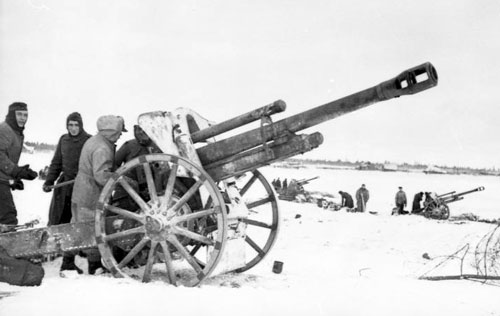Horsing Around: German WW2 Horse-drawn 105mm Light Field Artillery
Modelling Revell's leFH 18 Horsedrawn kit and Cossacks
I seem to have developed a Russian/East front theme to my modelling and painting in the last week. First the IS-2s and now the Revell Cossacks, throwing in the Cossack with a horse on foot strangely included in their Infantry set.
Have been basing the infantry for FoW, then worked on the Cossack Cavalry. Whilst most modelers will bemoan the presence of the Cossack on foot in the infantry set, I found it useful. The Cossacks can dismount in FoW, send their horses to the rear, and fight on as regular infantry. The dismounted guy will be useful for this, and can also double as an officer with the seated officer with binoculars from the Cossack set for unit command .

An excellent site about our passion. Recommended reference.
Having built and based these guys I thought I'd stick with the horse theme, and proceeded to work on the German Field Artillery with the LeFH 18 10.5cm field guns. Much to my delight the guns are very detailed, more so than the Zvezda kits I have used before.
In fact on the table it can be hard to distinguish the Zvezda LeFH 18 from a PAK 40. With the Revell kits there are no doubts.The reason is that two different carraiges are modeled, the earlier model with spoked wheel, the latter with the Pak 40s carriage. The Revell kit also does not have the muzzle brake.
See details below.
German leFH18:
The 10.5 cm leFH 18 (German: leichte FeldHaubitze "light field howitzer") was a German light howitzer used in World War II.
The 10.5 cm leFH 18 was the standard divisional field howitzer used by the Wehrmacht during the Second World War. It was designed and developed by Rheinmetall in 1929-30 and entered service with the Wehrmacht in 1935. Generally it did not equip independent artillery battalions until after the Battle of Stalingrad in 1943. Before 1938 the leFH 18 was exported to Hungary and Spain. 53 were also exported to Finland.
It had a heavy, simple breech mechanism with a hydro-pneumatic recoil system. The 10.5 cm leFH 18 had wood-spoked or pressed steel wheels. The former were only suitable for horse traction. Initially, it was not fitted with a muzzle brake. In 1941 a muzzle brake was fitted to allow longer range charges to be fired. This increased the range by about 1,800 yards and was known as the leFH 18M.
In March 1942 a requirement was issued for a lighter howitzer. This led to a second modification, known as the leFH 18/40. This modification consisted of mounting the barrel of an leFH 18M on the carriage for a 7.5 cm PaK 40 antitank gun. The new carriage increased the rate of fire as well as making the howitzer lighter. Additionally, a more efficient muzzle brake was added, decreasing the recoil. Ballistically, the 10.5 cm leFH 18M and the leFH 18/40 are identical.
During the French campaign the leFH 18 was often pressed into service in the anti-tank role when isolated pockets of heavily armoured French tanks, like the Char B and Somua, made breakthroughs. The 10.cm leFH 18 and the famed "88" were often the only weapons available.
While its weight proved useful in its sturdy construction and as a stable firing platform, it was a draw back when it came to manoeuvrability. It weighed 1985 kgs, which increased to 2050 kgs once the muzzle brake was added. During the Russian winter of 1941/42 the mud proved too much for many leFH 18. Many were abandoned to be captured by the Soviets when their crews could not drag them from the mud. Despite being designed with motor traction in mind, the German artillery still relied heavily on horse drawn limbers as it’s main means of motive power.

During 1942 thought was put into how to over come this design flaw. The final result was the leFH 18/40 which utilised the much lighter PaK 40 trail and wheels (wider wheels were introduced later) for its carriage, though the result wasn’t substantially lighter than its predecessor, 1900 kgs, its was put into production in 1942. The leFH 18 continued to be the main form of artillery in the German army, the introduction of the leFH 18/40 merely supplementing those already in service.
A total of 6986 leFH 18s and 10265 leFH 18/40s were manufactured during the war to add to those already in service in 1939.
The Germans did consider a complete redesign, Krupp, Rheinmetall and Skoda put new designs forward, but none of these designs were adopted.The 10.5 cm leFH 18 howitzer was a good weapon that served the Wehrmacht well. It maybe thought of as the plain Jane of the German gun arsenal when compared to more glamorous contenders like the 8.8cm FlaK 36 and the 7.5 cm PaK 40, but in overall damage done to the Allies the leFH 18 would be hard to beat.








































